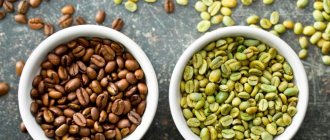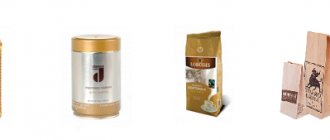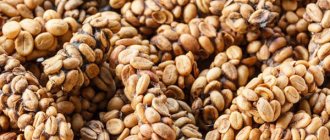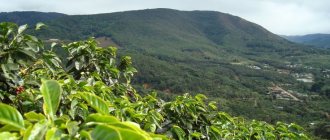The most complete guide to types of coffee: from variety and roasting to recipes
Cezve
– a traditional vessel for making coffee, known since the times of the Ottoman Empire.
He came to Russia during the Russian-Turkish wars and received the name “Turk”. It’s easy to brew coffee in a cezve, it’s inexpensive and suitable for anyone. We wrote more about how to choose a Turk here>>
French press
– a popular device for brewing coffee, and an ideal find for the lazy, as well as Specialty lovers.
You can read how to choose a French press and brew really delicious coffee in it here >>
And in this video, our expert Vyacheslav Poschishchailo prepares exemplary coffee in a French press and shares unobvious secrets:
Geyser coffee maker (moka)
– the most popular coffee maker in Italy.
Inventor Alfonso Bialetti claimed that he had found a way to make espresso in any kitchen, but coffee prepared in a moka would still be different from that brewed in a coffee machine. Read more in this article>>
Chemex
- almost a chemical laboratory in the kitchen. A Chemex is a glass container with a funnel, shaped like a watch. It is considered the best option for making specialty coffee because it allows the natural taste to reveal itself.
Purover
– a compact funnel cup that comes complete with disposable or reusable filters. Spiral hot water through the ground coffee. The result is a drink with a soft and pleasant taste. See how it happens:
Cold brew
– both the name of the drink and the method of preparing coffee. It differs in that freshly ground coffee is poured with cold water and infused for 8 to 24 hours, depending on what taste and strength you want to get in the end. Read our material on how to brew cold brew correctly.
Recipes for making coffee drinks
All coffee recipes are divided into 2 types: hot and cold.
Hot coffee drinks
Espresso and all drinks based on it, coffee prepared in Turkish and other alternative methods, as well as coffee alcoholic cocktails, for example, Irish coffee, are served hot.
Each classic recipe has its own characteristics: from the choice of the correct roasting and grinding of beans to the water temperature, preparation time of the drink and various additives that better reveal the taste of coffee. For example, if you brew coffee in a Turkish coffee pot, try adding a pinch of salt to it:
When preparing coffee in a geyser coffee maker, use hot water instead of cold - this will make the drink more aromatic and not over-extract.
Cold coffee drinks
Iced coffee drinks can vary in how they are prepared. So, cold brew and nitro coffee (carbonated cold brew) are initially infused with cold water. Ice latte, frappe, and Vietnamese coffee (also popular throughout Southeast Asia) are made from chilled coffee with ice and cold milk.
The coffee itself in Vietnam is prepared in a special press, using, as a rule, robusta or mixtures with a high content of robusta. This unique device with two filters allows you to prepare coffee using the drip method, directly into the cup:
Frappe
– instant or ground coffee, whipped with milk, sugar and ice.
Ice latte
, made popular by Starbucks, is a drink of their chilled espresso, milk, syrup and ice, mixed by hand in a glass or shaker.
By the way, there is a myth that hot coffee has a more effective effect on the body than cold coffee. But this nuance depends only on your personal preferences (and on the time of year when you drink coffee). The amount of caffeine and its effect on your body does not depend on the temperature of the drink.
Barley coffee production technology
To produce a coffee substitute, organic barley is used, grown without chemical fertilizers and pesticides. The collected grains are cleaned of foreign impurities. Then the hard shell is removed, since the husk can ruin the appearance of the drink. In Italy, special varieties of hulless barley are cultivated that require minimal processing.
The prepared raw materials are fried in cylindrical drums at a temperature not exceeding 200 °C. Then the grains are cooled using special devices and packaged in sealed bags. Companies produce different types of barley coffee: grain, ground and in capsules. Instant varieties are produced using a technology similar to the production of regular coffee.
Ethiopian coffee expressions
Perhaps one of the most powerful reflections of coffee's role in Ethiopian culture is its language. Coffee plays such an ingrained role in Ethiopian culture that it appears in many expressions relating to life, food and interpersonal relationships.
One of the common Ethiopian coffee sayings is “Buna dabo naw.” This literally translates to “Coffee is our bread.” It demonstrates the central role that coffee plays in terms of diet and demonstrates the level of importance placed on it as a source of nutrition.
Another common saying is “Buna Tetu”. This is an Amharic phrase that literally means "to drink coffee." This is much like how people use the phrase "meet for coffee" in English.
If someone says, “I have no one to have coffee with,” this is not taken literally, but it is assumed that this person does not have good friends whom he can confide in. This is closely related to the huge social role that coffee consumption plays in Ethiopia and the fact that people often gather over coffee for conversations that touch on daily life, gossip and deeper issues. Likewise, if someone says, “Don't let your name get noticed during coffee,” it means you should watch your reputation and not become the subject of negative gossip.
Types of cereal products
In stores in the diet food departments you can buy instant drinks, which, in addition to barley, include natural coffee, rose hips, chicory, cardamom, and medicinal herbs. Ready-made insoluble preparations are also sold - fried ground seeds, which just need to be cooked in a Turk.
Instant products:
- Coffee "Barley ear". The drink has been produced. Contains barley and chicory. Packaged in a bright, soft container with a convenient reusable clasp. The powder has a bready smell; when brewed with boiling water, a lush, thick foam forms, which then disappears. Recommended to be consumed with cream and sugar. It has a low price, accessible to everyone.
- "Health". Manufacturer: Coffee LLC. The drink has a mild taste, vaguely reminiscent of natural coffee, and dissolves well.
- "Golden Ear". A substitute for natural coffee made from roasted barley and rye has a specific bitter taste that can be drowned out with sugar, cream, and condensed milk.
- "Old Mill". The product is produced in Russia, does not contain caffeine, and has valuable nutritional properties. The disadvantage of barley powder is poor solubility; lumps remain.
- Barley coffee "Happiness". Made from selected barley grains, ready in 10 minutes. It is not addictive and does not harm the body. It has an amazing taste, an invigorating, tonic effect, and helps to get rid of excess weight. It can be consumed by people with diabetes and those for whom coffee is contraindicated.
- "Crastan Orzo". The healthy drink is produced in Italy and is sold in a can containing 125 grams of the product, additionally protected with a foil lid. Used at any time of the day, does not contain sugar or caffeine.
You might be interested in Coffee with liqueur and syrup
Insoluble cereal drinks:
- "Kurzeme";
- "People's"
- "Golden Ear";
- "Morning";
- "Children's";
- "Barley amateur."
Coffee ceremony
Coffee is so important to Ethiopians that they literally drink it for hours every day. The coffee ceremony is the most important social connection in Ethiopian culture. An invitation is a sign of respect and friendship.
Each ceremony lasts 2-3 hours, and families usually perform 2-3 of these ceremonies per day. This is an event for the whole family, where even children participate in serving coffee to elders. Guests are often invited and conversations can range from politics to the local community and more.
Fresh coffee is roasted in a pan, ground by hand using a tool similar to a mortar and pestle, and slowly brewed in a traditional clay pot, simmering over an open fire. The coffee is poured slowly so that the grounds do not spill out along with the coffee.
Many people drink coffee with a spoonful of sugar, but never with milk. More water is poured into the pan and boiled 2 more times, becoming weaker with each brew. While they may not be as tasty, the 2nd and 3rd brews are just as important as the first.
Methods for making barley coffee
You can roast barley for coffee yourself; to do this, the grains are first washed and dried.
There are two cooking methods:
- in the oven at a temperature of 170-180 °C;
- in a frying pan over low heat.
To ensure even frying, shake the pan periodically, trying to avoid burning. The finished product is characterized by an amber color and the smell of fresh baked goods. The barley is then ground in a coffee grinder. The powder does not tolerate high humidity, so it is recommended to use it immediately and not make reserves for future use.
Brewing recipes
- Pour 3 teaspoons of powder into a glass of water, bring to a boil in a pot, add sugar.
- Dilute 150 ml of whole milk with half and half water, put on fire, bring to a boil, add 5 teaspoons of ground barley, cook for 2-3 minutes.
- Heat a ceramic cup, add 3 teaspoons of barley powder and sugar to taste. Pour in a small amount of hot water, stir, top up, close with a lid and let stand for 4-5 minutes.
You can safely experiment with the drink - add honey, syrup, lemon or ice cream. To give coffee a rich color and aroma, barley is mixed with chicory.
Ethiopian coffee varieties
The mild climate and fertile soils make it possible to grow Arabica beans, highly valued by lovers of the invigorating drink. The best coffees from Ethiopia are in high demand in the world market.
Sidamo
Gourmets note the chocolate tones and caramel-creamy aftertaste in the taste of this drink. The sourness is unobtrusive and very light. The aroma of coffee is floral, slightly fruity.
Yirgachif
These grains belong to elite varieties. In the drink made from them, you can feel the bright tones of chocolate, and the aftertaste is dominated by citrus notes. The aroma is especially interesting - it smells of vanilla, bergamot and tropical fruits.
Harar
Refers to semi-wild varieties. The appearance of the grains is quite unpresentable - the beans are small and uneven. But behind the discreet shell lies a refined taste with almost imperceptible sourness and obvious tones of nuts and citrus fruits.
Taste of the drink
This cereal drink tastes much softer than natural coffee. It has a pleasant bready aroma. When cooked, a dense and high foam is obtained. When adding milk, it tastes most like cappuccino. You can get a coffee aroma and taste by adding a little chicory.
Barley decoction can be considered as one of the alternatives to natural coffee. It is beneficial for the body, does not overstimulate the nervous system, and has a pleasant taste and aroma. Barley coffee is easy to prepare at home, and both adults and children can drink it.
Useful properties and calorie content
The cereal and its decoction contain a lot of fiber and protein, vitamins B1-B4, B6, B8 and B9, E, A, D, as well as potassium and magnesium, iodine, phosphorus and other micro- and macroelements, including dietary fiber, beta-glucans, which are involved in cleansing the body of cholesterol, toxins and other harmful substances.
Barley coffee is a powerful natural antioxidant. It quickly restores strength, normalizes sleep, helps with weight loss, slows down the absorption of carbohydrates, normalizing glucose levels.
The drink is effective for the treatment and prevention of dysbiosis, liver and kidney diseases, has a choleretic effect, helps with colds, arthritis and rheumatism.
The decoction also contains lysine and silicon, which are involved in the process of producing collagen in the body - a protein responsible for the firmness and elasticity of skin, hair and cartilage.
Coffee made from barley has a positive effect on the cardiovascular system, improves hematopoietic processes and stabilizes the water-salt balance. You can drink it for gastritis and even stomach ulcers.
Since barley is a cereal grain, three-quarters of its composition is carbohydrates. That is why barley drink is relatively high in calories: one cup of such coffee without additives contains 20-25 kcal. If you're watching your caloric intake, pay attention to this.
There is no caffeine in the decoction, it does not stimulate the nervous system, for which barley coffee was even nicknamed “children’s coffee.”
Public opinion
People who care about their health tend to make barley coffee and leave reviews about it:
Inna Ostapova, Moscow: “I bought a 100-gram pack for 35 rubles. Contains rye and barley. The taste is pleasant, milky-cereal, the smell is sweetish, burnt, not particularly expressive. It cooks quickly, just stir a couple of spoons in hot water. Lumps appear that need to be whisked. Thanks to the drink, my husband and I limited our coffee consumption, which saved us a lot financially.”
Sergey Popov, Togliatti: “I am a long-time coffee lover, I drink 6-7 cups a day. When I felt that I had problems with my heartbeat, I decided to replace my favorite drink with something, since I couldn’t give it up completely. A friend recommended a natural substitute - barley coffee. I haven’t gotten used to the taste yet, the bready smell confuses me, but I noticed the benefits for the body after a week. The general level of vigor has increased, blood pressure and heart rate have normalized.”
Elena Portnova, Tatarstan: “I am a housewife, I have a lot of free time, so making coffee from barley is a pleasure for me, not work. I fry them according to my own taste; when I want a more bitter drink, I overcook them a little, when I want a softer drink, I overcook them a little. I pour it into a glass jar and enjoy. I noticed that the extra pounds disappeared, my complexion improved, and my hair stopped falling out. The taste of barley coffee is pleasant, I add a little milk.”
By including barley drink in your daily diet, you can renew your body, cleanse it and gain excellent health.











